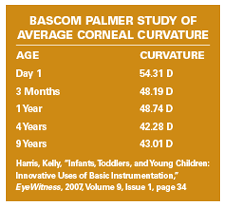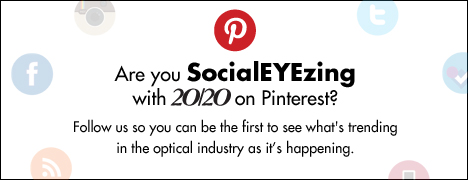|
Your monthly guide to staff training outside the box
Eyes / Lenses / Fitting Lenses / Free-Form / Frames / Sunwear / Patient Solutions / In-office / Standards
PATIENT SOLUTIONS, Kids
EXPLAIN TO PARENTS
If eyecare professionals don't take the time to explain to the parent about what qualities to look for in frames, lens material and lens design, in their eyes these products are just commodities. Unless ECPs take the time to talk about the difference in the lenses that come out of our practices, all lenses are equal in the parent's eyes. But once they understand the importance of children-designed frames and the right lenses, parents are empowered to make a decision that is based on more than just price and insurance coverage.
To ensure compliance with wearing eyeglasses, there has to be a balance between parental and child preferences. For example, a parent who chooses a bright red or blue frame should not be surprised when the child does not want or like to wear their glasses. It may simply be the color. But clearly the decision should not be solely left up to the child either. It is important to engage both parties—the parent and the child—in order to help realize a visual solution that works well. Children will also be reluctant or refuse to wear their glasses if they're experiencing distortion and/or discomfort. Lenses should be safe, clear and comfortable to wear.
See Plus »
|
|


|
Helpful Info – General Assumptions
- Plus or minus power for a toddler is probably prescribed to treat strabismus—esotropia if a plus power and exotropia if a minus power.
- An Rx written for a child aged 10 or over is usually prescribed because of a refractive error, which wearing glasses will not "cure."
- Plus power, bifocal prescriptions probably indicate accommodative esotropia.
- Modest powers for younger children probably are prescribed to prevent amblyopia.
- Left untreated, strabismus could lead to amblyopia.
- If amblyopia is not treated prior to visual maturity, the child may suffer permanent vision loss not correctable by surgery, spectacles or contact lenses.
See Plus »
|
Contact Lens Procedures for Young Children

Contact lenses frequently are a good choice for correcting vision in young children. In correction following surgery for congenital cataracts and in aniseikonia, contact lenses reduce differences in image size between eyes and improve peripheral vision. In amblyopia, an occluder or opaque contact lens is preferable to a patch because it's easier to keep in place. In fact, contact lenses solve the problem for parents who have to keep glasses clean, comfortable and in place for
many children who need vision correction.
As with the eye exam, be flexible and creative with fitting procedures. Handheld keratometers reduce the difficulty in obtaining corneal curvature readings. When children are too young even for a handheld keratometer, the Bascom Palmer averages of corneal curvature provide a good starting point. The averages are based on age, ranging from birth to 9 years.
See Plus »
|
Why Does My Baby Need Glasses?

There are many possible causes requiring young children to wear glasses. These are the most commonly encountered reasons corrective eyewear is dispensed to children under 5 years old: Anatomical, because all children are physically small, their eyeballs are too. In addition, when an eyeball is smaller than is ideal, light will come to a focus behind the retina; the result is farsightedness. Therefore, it is important to convey to the parent that all children are born farsighted because the eyeball or globe is small. Nevertheless, since most children's eyes are able to compensate (accommodate) for this state, they usually do not need any visual help. Neurological, the proper neurological development of a child's visual system requires both eyes to work together. As learned in anatomy, there is a linked relationship between the eye's close focus or accommodation, and the need to turn in, or converge.
See Plus »
|
According to...

- The U.S. Census: There are about 75 million kids in the population under 18. In fact, in five-year increments, there are about 20 million in each group.
- The American Public Health Association: About 1 in 20 preschoolers have eye or vision problems that they can't describe so go undetected.
- A June 2013 American Optometric Association (AOA) press release: Most Americans know the importance of UV-blocking sunscreen to protect their skin from aging and diseases. Unfortunately, according to the recent American Eye-Q survey funded by the AOA, only 32 percent of Americans understand the same is true when it comes to protecting their eyes from aging and diseases.
See Plus »
|
HOME PLATE
Probably the toughest part of our job is communicating the importance of the right outdoor eyewear and sport eyewear to parents. Fitting children offers a unique sales problem. We can't lose sight of the fact that even though the child is our patient, he or she is not our customer. In most sales situations, the patient and customer are the same person, but our real customer is the parent and most often Mom. We have to convince Mom that sport eyewear is worth the price by explaining what they are actually doing.
Nearly every parent who walks into my office is worried about little Johnny ruining his glasses when he's playing sports in his fashion eyewear. The frames could be broken by being knocked to the ground and stepped on. They never recognize the fact that ruining his glasses is inconsequential to the risk of ruining his eyes when he's playing sports. It's hopeless trying to justify the purchase of a $250 pair of sport goggles to protect a $250 pair of street eyewear. However, the balance changes dramatically when you point out that sport eyewear isn't designed to save his glasses, they are designed to save his sight.
I often remind parents and kid how they are required to wear mouth guards, even though, honestly, false teeth could work as well as real teeth. If we are so focused on protecting our teeth, what about protecting our eyes? "False eyes don't work nearly as well as false teeth." When you frame things in that light, parents will find it hard not to place a high value on the only two eyes their child will ever have.
—Danielle Crull, ABOM
See Plus »
|
|


|
|